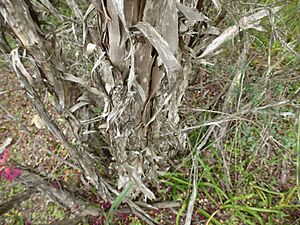Granite bottlebrush facts for kids
Quick facts for kids Granite bottlebrush |
|
|---|---|
 |
|
| Melealuca elliptica flowers, buds and fruit | |
| Scientific classification | |
| Genus: |
Melaleuca
|
| Species: |
elliptica
|

The Granite Bottlebrush (scientific name: Melaleuca elliptica) is a beautiful plant from the myrtle family. It's special because it only grows in the southern part of Western Australia. The Noongar people, who are the traditional owners of the land, call this plant gnow.
Many people like to grow the Granite Bottlebrush in their gardens. It has bright red, brush-like flowers and neat leaves. To keep it looking good, it needs regular trimming. In the wild, it often grows in bushy areas or woodlands.
Contents
What the Granite Bottlebrush Looks Like
The Granite Bottlebrush is a shrub that usually grows up to about 4.5 meters (15 feet) tall and 2 meters (7 feet) wide. It has pale grey, papery bark.
Leaves and How They Grow
Its leaves are arranged in a special way. They grow in opposite pairs, with each pair at a right angle to the ones above and below it. This makes four neat rows of leaves along the stems. The leaves are shaped like an oval or an egg, usually with rounded ends. They are about 6 to 20 millimeters (0.2 to 0.8 inches) long and 3 to 10 millimeters (0.1 to 0.4 inches) wide. Each leaf has a short stem.
Flowers and Fruit
The flowers grow in spikes on the sides of the branches. Each flower spike can be up to 65 millimeters (2.6 inches) across and 80 millimeters (3.1 inches) long. Each spike has between 20 and 60 individual flowers.
The flowers are usually dark red, but they can also be pinkish-cream. They bloom for a long time, from August all the way to April. The petals are thin and brown, about 4 to 6 millimeters (0.16 to 0.24 inches) long. They fall off as the flowers get older. The plant's fruit are woody capsules, which are like small, hard seed pods. They are about 5 to 6 millimeters (0.2 to 0.24 inches) long and 8 millimeters (0.3 inches) wide. These capsules form in groups along the stem.
Naming the Granite Bottlebrush
The scientific name for this plant, Melaleuca elliptica, was first officially described in 1806. A botanist named Jacques Labillardière gave it this name. The word elliptica comes from a Latin word meaning "elliptic," which describes the oval shape of its leaves.
Where the Granite Bottlebrush Grows
The Granite Bottlebrush grows in the southern part of Western Australia. You can find it from Bendering in the west, to the Ongerup area in the south, and as far east as the edge of the Nullarbor Plain. It likes to grow in sandy soils, often near large granite rocks, in woodlands and heathlands.
How We Protect This Plant
The Government of Western Australia's Department of Parks and Wildlife has listed Melaleuca elliptica as "not threatened." This means it is not currently in danger of disappearing.
Growing Granite Bottlebrush in Gardens
This plant is well-known to gardeners because it is very tough and easy to grow. It does best in sunny spots with soil that drains well. It can handle frost and adapts to most places in areas with mild climates.
To keep the plant looking its best and to encourage more flowers, it needs to be trimmed regularly. Since the flowers usually grow on older branches, careful trimming can help show off the beautiful blooms.



